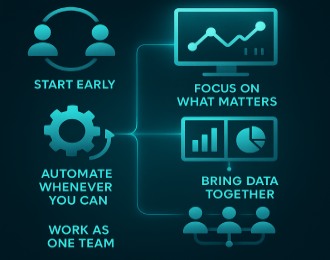Real-Time Feedback Loops Accelerate Delivery
One of DevOps’ greatest strengths is its focus on continuous feedback and real-time analytics amplifies this advantage. Real-time insights enable a team to identify problems immediately when they occur and maintain delivery pipelines without issues. Rather than waiting to be notified on the reports or test results, developers are informed instantly of code coverage drops, test failures or deployment errors.
This immediate visibility also promotes experimentation. Developers are able to make a lot of minor updates and they are sure of prompt feedback on the performance of the changes. The fact that it accelerates delivery, as well as having a reduction in frustration in prolonged testing cycles.
Collaboration between development and operations is also enhanced with the help of real-time analytics. When both teams share the same live data from build results to performance metrics, they can quickly pinpoint issues together instead of debating their causes. This visibility also aids in minimizing the downtimes and accelerates recovery time.
From Reactive Firefighting to Proactive Prevention
DevOps teams tend to resort to reacting only to problems only after they have been experienced by the users without real-time analytics. Real-time data changes that completely as it allows teams to transform operations from reactive to proactive.
Early Warning Through Anomaly Detection
Real-time analytics to sustain continuous monitoring assists teams to identify abnormal patterns before they transform to major challenges. As an illustration, a progressive increase in memory consumption could be an indication of a memory leak. Early detection also provides an opportunity to engineers to correct the issue by means of preventing downtime or poor performance.
Predictive Insights with Machine Learning
Modern tools in DevOps have AI-powered analytics that are beyond simple alerts. These systems conduct the analysis of historical and live data to forecast possible failures. These trends can be identified in time so that teams can perform maintenance early and even schedule workloads before users realize that something has gone wrong.
Smarter Incident Response
Incidents that occur are quickly responded to through the use of real-time analytics. All events, logs, performance values are tracked and time stamped and thus, it becomes simpler to create the connect the dots. Teams can now find it easier to pinpoint the source of the problem, diagnose and implement specific remedies.
Best Practices for Implementing Real-Time Analytics in DevOps
Real-time analytics cannot be used without a clear set of goals and strategy that should guide DevOps teams in their implementation. A few basic methods of making it work are the following:

- Start Early: Do not start considering analytics at the time of production. Monitoring and alerts can be installed at a very early stage of your CI/CD pipeline in order to ensure you can spot any problems before they get big.
- Focus on What Matters: Track the metrics that matter to you and help you make a better decision like rates of error, rates of latency, or a failed build rather than numbers that look good but do not make action.
- Automate Whenever You Can: It is recommended to automate all repetitive alerts and rapid reactions. This is time-saving and it will help your team become more efficient in responding to the problems in case something goes wrong.
- Bring Data Together: Put your logs, metrics and traces into a single platform. The fact that everything is in one place gives you a better perspective of what is actually going on.
- Work as One Team: Share dashboards across departments so developers, testers and operations are on the same page. Teamwork is made easier through mutual visibility.
Final Thoughts
Real-time analytics is not just another DevOps tool but what keeps everything running smoothly. Teams are able to eliminate the possibility of guessing by identifying problems at an early stage and making intelligent decisions. It changes the aspect of reacting to problems to prevent them altogether.
It is all about bringing the teams to collaborate and produce reliable software that is faster at the end of the day.